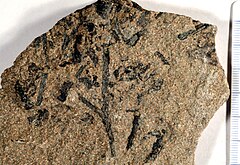| Yahatinda Formation | |
|---|---|
| Stratigraphic range: Givetian ~387–383 Ma PreꞒ Ꞓ O S D C P T J K Pg N ↓ | |
 Fossil plant (a trimerophyte) from the Yahatinda Formation Fossil plant (a trimerophyte) from the Yahatinda Formation | |
| Type | Formation |
| Underlies | Flume Formation |
| Overlies | Cambrian to Ordovician formations |
| Thickness | Typically less than 30 m (98 ft) |
| Lithology | |
| Primary | Dolomitic sandstone, siltstone and mudstone |
| Other | Conglomerate and breccia |
| Location | |
| Coordinates | 51°44′00″N 115°43′30″W / 51.73333°N 115.72500°W / 51.73333; -115.72500 (Yahatinda Formation) |
| Region | |
| Country | |
| Type section | |
| Named for | Ya-Ha-Tinda Ranch, Alberta |
| Named by | J.D. Aitken |
| Year defined | 1966 |
 | |
The Yahatinda Formation is a geologic formation of Middle Devonian (Givetian) age in the southwestern part of the Western Canada Sedimentary Basin in the mountains of southwestern Alberta. Its type locality lies the on the eastern face of Wapiti Mountain above Ya-Ha-Tinda Ranch at the eastern edge of Banff National Park. The Yahatinda contains a variety of Devonian fossils.
Lithology
The Yahatinda Formation includes both terrestrial river channel and littoral marine sediments. The channel deposits, which are well exposed at the type locality, consist of reddish, medium- to coarse-grained, cross-bedded dolomitic sandstones, siltstones, conglomerates and breccias. The channels contain eroded cobbles and boulders from the older underlying formations, as well as the remains of land plants and freshwater fish.
The littoral deposits consist of micritic mudstones and dolomitic mudstones that are thought to have been deposited in intertidal to supratidal environments. These sequences include paleosols, calcrete and dolocrete.
Thickness and distribution
The Yahatinda Formation is present as discontinuous outcrops in the front ranges of the Canadian Rockies in Alberta, from the Brazeau River in the north to near the Kananaskis Lakes in the south, and possibly at Mount Wilson in extreme southern Alberta.
The thickness of the Yahatinda is highly variable because it was deposited on an erosion surface with high topographic relief. It is typically less than 30 m (98 ft) thick and is absent over paleotopographic highs, but it can reach thicknesses as great as 265 m (869 ft) in deeply incised paleovalleys.
Relationship to other units
The strata of the Yahatinda Formation were originally included in the Ghost River Formation, but that formation name was later abandoned. The Yahatinda rests unconformably on formations that range in age from late Cambrian to early Ordovician. It is overlain by the Flume and Cairn Formations of the Fairholme Group. It was deposited along the east side of the Western Alberta Ridge, a paleogeographic feature that existed at that time, and it is equivalent to the Cedared Formation that was deposited on the western side of the ridge. It is equivalent in age to the upper part of the Elk Point Group in the basin to the east.
Paleontology
Plant fossils and remains of freshwater fish are found in the channel sediments of the Yahatinda. Branched stems of Archaeopteris (Callixylon) up to 13 centimetres (5.1 in) in diameter, some with attached sporangia, have been described from the type area, as have possible remains of Rhacophyton (an ancestral fern), Svalbardia (a branching plant with needle-like leaves), and others. Remains attributed to the freshwater fish Coccosteus and other fish fragments have also been reported.
See also
References
- Aitken, J.D. 1966. Sub-Fairholme Devonian rocks of the eastern Front Ranges, southern Rocky Mountains, Alberta. Geological Survey of Canada, Paper 64-33, 88 p.
- ^ Glass, D.J. (editor) 1997. Lexicon of Canadian Stratigraphy, vol. 4, Western Canada including eastern British Columbia, Alberta, Saskatchewan and southern Manitoba. Canadian Society of Petroleum Geologists, Calgary, 1423 p. on CD-ROM. ISBN 0-920230-23-7.
- ^ McGregor, D.C. 1963. Paleobotanical evidence for the age of basal Devonian strata at Ghost River, Alberta. Bulletin of Canadian Petroleum Geology, vol. 11, no. 3, p. 267-287.
- Williams, C.A. and Krause, F.F. 2000. Paleosol chronosequences and peritidal deposits of the Middle Devonian (Givetian) Yahatinda Formation, Wasootch Creek, Alberta, Canada. Bulletin of Canadian Petroleum Geology, vol. 48, no. 1, p. 1-18.
External links
- Various Contributors to the Paleobiology Database. "Fossilworks: Gateway to the Paleobiology Database". Retrieved 17 December 2021.
- Geologic formations of Alberta
- Devonian System of North America
- Devonian Alberta
- Givetian Stage
- Sandstone formations
- Siltstone formations
- Mudstone formations
- Conglomerate formations
- Fluvial deposits
- Tidal deposits
- Western Canadian Sedimentary Basin
- Devonian southern paleotropical deposits
- Fossiliferous stratigraphic units of North America
- Paleontology in Alberta